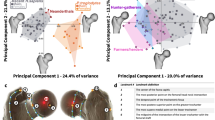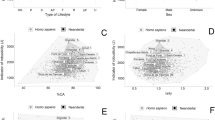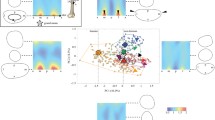Abstract
To understand the mechanical effects of different modes of locomotion on the femoral neck of chimpanzees, we investigated the cross-sectional morphology of the femoral neck of 4 chimpanzees (Pan troglodytes schweinfurthii) collected from the Mahale Mountains, Tanzania. We performed serial computed tomography (CT) scans of the neck from the femoral head to the base of the neck perpendicular to the long axis of the neck. We measured the cortical thickness of the serial 5 cross sections of the neck region every 45° around the circumference, i.e., 8 points per section, and examined the cross-sectional properties of the mid-section. When we compared the superior and inferior parts of the cortical thickness of the femoral neck, the inferior part exhibited the greatest cortical thickness whereas the superior part had the smallest values in every specimen. Researchers have also observed such regional differences between superior and inferior cortical thicknesses in bipedal humans and other primates, although these differences are not as large in the chimpanzee as in bipedal hominini. The present study differed from the past study on hominini and chimpanzees in that the superior anterior (SA) part exhibited greater cortical thickness in chimpanzees. We believe these observations reflect the structural strengthening of parts of the chimpanzee femoral neck that is needed to accommodate the mechanical loads imposed by arboreal vertical climbing and terrestrial quadrupedal and bipedal locomotion.











Similar content being viewed by others
References
Carlson, K. J., Doran-Sheehy, D. M., Hunt, K. D., Nishida, T., Yamanaka, A., & Boessch, C. (2006). Locomotor behavior and long bone morphology in individual free ranging chimpanzees. Journal of Human Evolution, 50, 394–404.
Demes, B., Jungers, W. L., & Walker, C. (2000). Cortical bone distribution in the femoral neck of strepsirhine primates. Journal of Human Evolution, 39, 367–379.
Doran, D. M. (1993). Sex differences in adult chimpanzee positional behavior: the influence of body size on locomotion and posture. American Journal of Physical Anthropology, 91, 99–115.
Galik, K., Senut, B., Pickford, M., Gommery, D., Treil, J., Kuperavage, A. J., et al. (2004). External and internal morphology of the BAR 1002’00 Orrorin tugenensis femur. Science, 305, 1450–1453.
Gunji, H., Hosaka, K., Huffman, M. A., Kawanaka, K., Matsumoto-Oda, A., Hamada, Y., et al. (2003). Extraordinarily low bone mineral density in an old female chimpanzee (Pan troglodytes schweinfurthii) from the Mahale Mountains National Park. Primates, 44, 145–149.
Harmon, E. H. (2007). The shape of the hominoid proximal femur: a geometr ic morphometric analysis. Journal of Anatomy, 210, 170–185.
Hosaka, K. (1995). A single flu epidemic killed at least 11 chimps. Pan Africa News, 2, 3–4.
Kalmey, J. K., & Lovejoy, C. O. (2002). Collagen fiber orientation in the femoral necks of apes and humans: Do their histological structures reflect differences in locomotor loading? Bone, 31, 327–332.
Kimura, T. (1996). Centre of gravity of the body during the ontogeny of chimpanzee bipedal walking. Folia Primatologica (Basel), 66, 126–36.
Lovejoy, C. O. (1988). Evolution of human walking. Scientific American, 259, 118–125.
Lovejoy, C. O., Meindl, R. S., Ohman, J. C., Heiple, K. G., & White, T. D. (2002). The Maka femur and its bearing on the antiquity of human walking: applying contemporary concepts of morphogenesis to the human fossil record. American Journal of Physical Anthropology, 119, 97–133.
Matsumura, A., Takahashi, Y., & Okada, M. (2002). Cross-sectional geometric properties along the diaphysis of femur and fumerus in chimpanzees and humans. Zeitschrift für Morphologie und Anthropologie, 83, 373–382.
Matsumura, A., Takahashi, Y., & Okada, M. (2006). Morphological adaptation of rat femora to different mechanical environments. In H. Ishida, R. H. Tuttle, M. Pickford, N. Ogihara, & M. Nakatsukasa (Eds.), Human origins and environmental backgrounds (pp. 123–133). New York: Springer.
Nakano, Y., Hirasaki, E., & Kumakura, H. (2006). Patterns of vertical climbing in primates. In H. Ishida, R. H. Tuttle, M. Pickford, N. Ogihara, & M. Nakatsukasa (Eds.), Human origins and environmental backgrounds (pp. 97–104). New York: Springer.
Ohman, J. C., Krochta, T. J., Lovejoy, C. O., Mensforth, R. P., & Latimer, B. (1997). Cortical bone distribution in the femoral neck of hominoids: implications for the locomotion of Australopithecus afarensis. American Journal of Physical Anthropology, 104, 117–138.
Rafferty, K. L. (1998). Structural design of the femoral neck in primates. Journal of Human Evolution, 34, 361–383.
Senut, B. (2006). Arboreal origin of bipedalism. In H. Ishida, R. H. Tuttle, M. Pickford, N. Ogihara, & M. Nakatsukasa (Eds.), Human origins and environmental backgrounds (pp. 201–208). New York: Springer.
Sockol, M. D., Raichlen, D. S., & Pontzer, H. (2007). Chimpanzee locomotor energetics and the origin of human bipedalism. Proceedings of the National Academy of Science of the United States of America, 104, 12265–12269.
Stern, J. T. (1972). Anatomical and functional specialization of the human gluteus maximus. American Journal of Physical Anthropology, 36, 315–340.
Stern, J. T., & Susman, R. L. (1981). Electromyography of gluteal muscles in Hylobates, Pongo, and Pan: implications for the evolution of hominid bipedality. American Journal of Physical Anthropology, 55, 153–166.
Takahashi, H., & Adachi, K. (1982). A program for calculating the geometrical properties of two-dimensional shape using a digitizer. Interface, 59, 200–214.
Tardieu, C., Aurengo, A., & Tardieu, B. (1993). New method of three-dimensional analysis of bipedal locomotion for the study of displacements of the body and body-parts centers of mass in man and non-human primates: evolutionary framework. American Journal of Physical Anthropology, 90, 455–476.
Uhlmann, K. (1968). Huft-und Oberschenkelmuskulatur Systematische und vergleichende Anatomie. Primatologia, 4, 435–442.
Volpato, V., Viola, T. B., Nakatsukasa, M., Bondioli, L., & Macchiarelli, R. (2008). Textural characteristics of the iliac-femoral trabecular pattern in a bipedally trained Japanese macaque. Primates, 49, 16–25.
Acknowledgments
A part of this study was presented in the Post Congress of the International Primatological Society, which was held in Durham in 2008. We thank Drs. T. C. Rae, Y. Hamada, and E. Hirasaki for giving us the opportunity to publish this work. We thank Drs. M. Hajima and T. Nakamura for their comments and support during data processing, and we also thank the anonymous reviewers for constructive and helpful suggestions, which helped to greatly improve the manuscript.
Author information
Authors and Affiliations
Corresponding author
Rights and permissions
About this article
Cite this article
Matsumura, A., Gunji, H., Takahashi, Y. et al. Cross-Sectional Morphology of the Femoral Neck of Wild Chimpanzees. Int J Primatol 31, 219–238 (2010). https://doi.org/10.1007/s10764-010-9403-9
Received:
Accepted:
Published:
Issue Date:
DOI: https://doi.org/10.1007/s10764-010-9403-9




